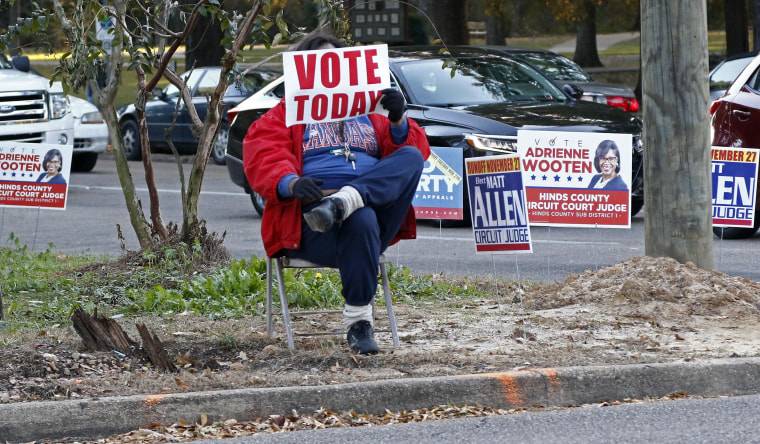The contours of the coalition Mike Espy assembled in Mississippi's Senate runoff are familiar ones for a Democrat in the Trump age: overwhelming support — and turnout — from nonwhite voters; a burst of energy around college campuses; and surprising new inroads in traditionally Republican suburbs.
It's a formula that helped fuel the party's takeover of the House this month, with Democrats flipping dozens of Republican seats and posting their strongest midterm election performance since the Watergate wave of 1974. But in Mississippi, it still added up to defeat on Tuesday, with Espy losing to Republican Sen. Cindy Hyde-Smith, 54 to 46 percent.
Not that this was surprising.
Mississippi is a deeply red state, obviously, one that last voted for a Democratic presidential candidate in 1976 and one that hasn't sent a Democrat to the Senate since 1982. In fact, by holding Hyde-Smith to a single-digit margin, Espy has now come closer than any Mississippi Democrat in 30 years to winning a Senate election.
Republicans can breathe a sigh of relief that the result wasn't even tighter, but it hardly represents a show of strength for them when the outcome of a Mississippi election is even slightly in doubt as the returns come in — something that was the case for about an hour on Tuesday night.
Overall, Espy fared 5 points better in the runoff than he did in the Nov. 6 general election, when he received 41 percent of the vote. In particular, he seems to have benefited from a motivated black electorate. With some ballots still to be counted, turnout for the runoff has met or surpassed its Nov. 6 level in a dozen of the state's 82 counties. And of those dozen counties, eight are majority-black, mostly in the Delta region, where Espy racked up enormous margins.
Espy's statewide total was also helped by the suburbs, especially fast-growing DeSoto County, which abuts the Tennessee border and has become a hotspot for Memphis commuters. Here, Espy collected 41 percent of the vote, far better than recent Democratic candidates like Hillary Clinton (31 percent in 2016) and Barack Obama (33 percent in 2012, and 30 percent in 2008).
He also broke 46 percent in Madison County, which sits outside Jackson and boasts the highest concentration of four-year college graduates in the state, outpaced both Clinton and Obama in Hinds County (home to Jackson), the state's biggest, and claimed 56 percent in Oktibbeha County, home to Mississippi State University, another significant improvement over Clinton and Obama.
Exactly why Espy posted these gains isn't clear. Very likely, Hyde-Smith's campaign trail comment about public hangings played a role, motivating Democratic voters and also prompting some culturally moderate suburbanites to abandon the GOP and vote for Espy. It's also possible some Republicans simply chose not to vote, maybe because of Hyde-Smith's behavior, or perhaps because of lingering intra-party tensions from her competition with Chris McDaniel in the Nov. 6 election.
It's also true that, as impressive as his performance was for a Mississippi Democrat, Espy needed more to actually have a chance of winning, and he didn't get it. In DeSoto, for example, where he won 41 percent, Espy probably needed to hit a number well into the mid-40s. He also suffered in many heavily white rural areas, especially in the northeast corner of the state, where Hyde-Smith ran close to — and in a few cases even matched — the levels of support Donald Trump received in 2016.
In that sense, the Mississippi result underscores both the potential and the limits that today's Democratic Party faces.
More than ever, the party is depending on nonwhite voters and college-educated professionals in metropolitan areas. In a state like Mississippi, with its heavily rural and racially polarized electorate, that's just not going to be enough for Democrats to break through and win, even when they catch a few breaks.
Given that Mississippi is such a Republican bastion, and a small one that that, this is not something Democrats are going to lose any sleep over. But what about, say, Ohio, where rural areas and small, older cities are pulling the state even further away from the Democratic Party as the Trump presidency progresses and as the 2020 presidential election gets underway?
There's a trade-off here, of course, and Democrats are increasingly confident they're on the right side of it. Maybe we'll lose Ohio from the battleground category in 2020, they'll say, but now we can replace it with Arizona and Georgia and Texas. And as they just demonstrated in this year's midterms, they are plenty capable of scoring a sweeping victory with their current coalition, which only adds to their confidence.
Of course, it also helped that Democrats have had the wind at their backs this year, thanks to a Republican president about whom a majority of Americans express negative views, often deeply negative views. Twice since the 1990s, though, presidents have gained political strength after midterm drubbings.
If he's going to make the Democrats' calculation look foolish, Trump will now have to become the third to do so.

